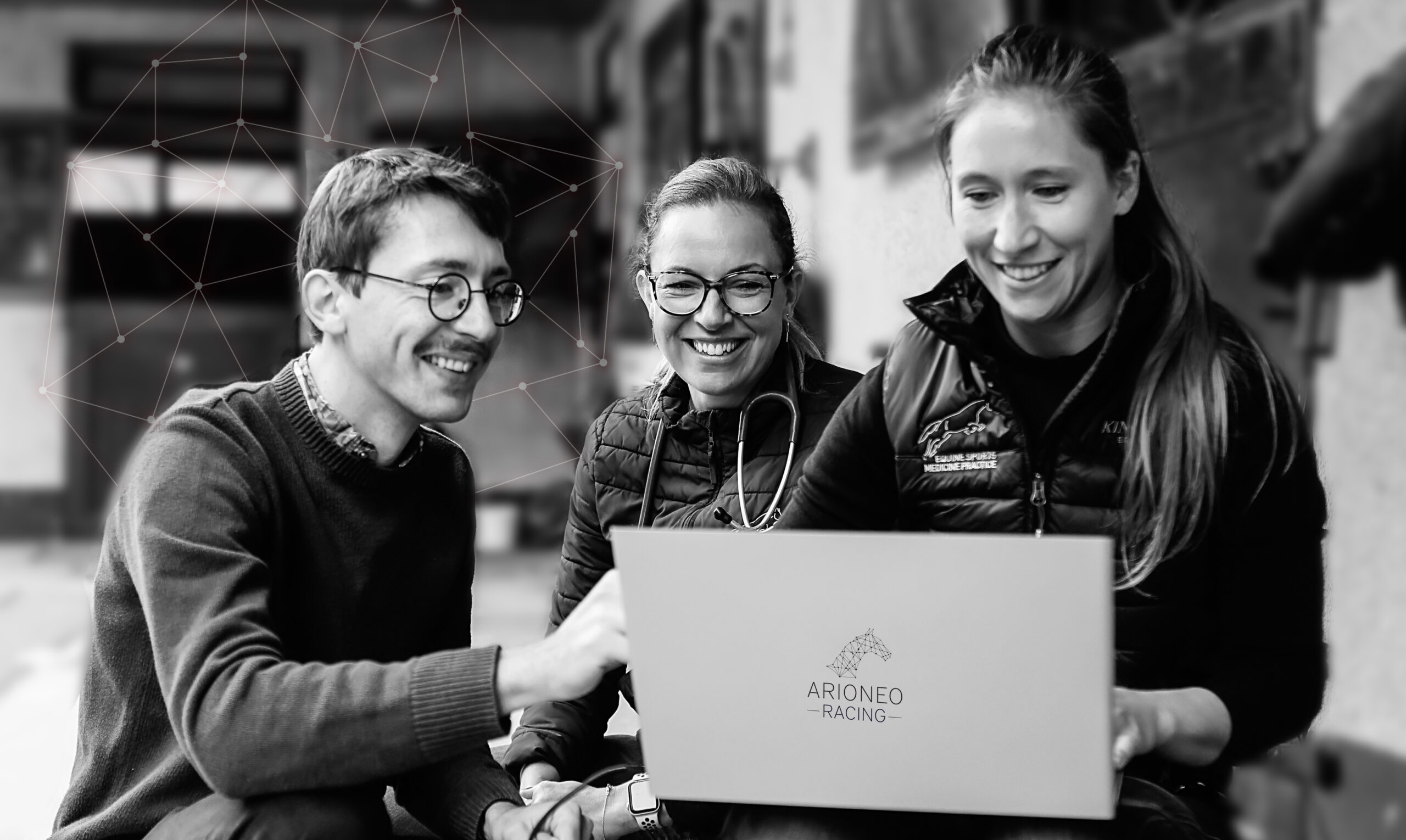RACEHORSE’S TRAINING MONITORING
Racehorse’s training monitoring is crucial to gain efficiency and competitiveness while preserving the physical and mental integrity of the horse athletes.
It is critical for a horse to have undergone training that is specific to its needs in order to perform well on race day. Collecting key data on a horse’s training i.e quantifying his training, is essential to ensure quality follow-up. Thanks to the data, sessions can be analyzed and compared to improve performance throughout the season. In addition, by monitoring the volume and intensity of training, you may also ensure that your horses do not acquire over or under-training syndromes or other pathologies.
On the agenda:
I – Why should you monitor your racehorses’ training?
- What are the benefits of quantifying training, workload and data evolution?
- Preparing a race with objective data
- Carry out a reinforced medical-sports follow-up
II – How to set up training monitoring?
III – What are the limits of training monitoring?
I – Why should you monitor your racehorses’ training?
One of the primary goals of athletic trainers is to establish a suitably high workload to develop the desired qualities, while controlling the amount of exhaustion caused by the training. As such, training monitoring allows for quantification of workload, evaluation of progress and carrying out a reinforced medical and sports follow-up.
1 – What are the benefits of quantifying training, workload and data evolution?
Quantify the workload of your athletic horses
First of all, monitoring training allows for quantifying the workload. For trainers, it is the best way to:
- Understand how the horse supported the effort: what was the intensity of the work? How much effort was made?
- Know which moments were the most difficult for him during this training: what are the weaknesses and strengths of your horses?
- Evaluate the efficiency of his energy metabolism: is your horse ready to run a race? Has he made any progress?
For instance, the heart rate data that can be collected with a heart rate monitor can be used to measure the level of intensity supported by the horse’s cardiovascular system during exercise.
Finding the right balance between under-training and overtraining
Quantifying training is, by extension, a valuable aid in finding the right balance between over and under-training. Through the collection of tangible data, one can make the horse talk and understand his body reactions or athletic performances.
What is the optimal training frequency for this horse? What type of training does he need to make progress?
Indeed, knowing the balance point of each racehorse is essential to ensure effective and adapted training that provides results while minimizing the risk of injury.
Improvement in physical performance can only be achieved by exposing an athlete to load beyond those to which he is accustomed. Of course, any increase in load must be carefully managed, balanced and controlled to ensure that horses are not at risk of injury. Horse athletic tracking technologies like Equimetre play a key role in this process, allowing you to identify and follow every key parameter of physical performance. This is especially important during an intensive phase. Thus, the data collected contribute to improving the efficiency of your program: the risk of injury is reduced while simultaneously the horse’s performance is optimized.
Quantify your young racehorses’ workload
Finally, assessing workload is particularly interesting for young horses that are just starting to train. By having tangible data, you can control the increase in workload and evolve gradually. It is very important not to rush the workload in order to encourage healthy growth and limit the risk of injury. Following the training allows you to develop your young horses while respecting their physical and mental integrity.
Attention to animal welfare has grown enormously in recent years: we need to make sure that horses are not put in the red by a proven methodology rather than a subjective “feeling”.
Emmanuelle Van Erck
Veterinarian and european specialist in equine internal medicine
Assess the horse’s evolution in the medium and long term
Quantifying training over the long term allows for the creation of data history, which is necessary for tracking progress over time. Indeed, it is possible to observe an improvement after several months of training with the naked eye. Still, the numerical comparison of performance allows us to see changes that aren’t evident to the naked eye across shorter time periods and to get more details on the progress made:
- How effective has the training been over a period of time?
- To what extent was it effective?
- Is it the horse’s fitness, locomotion or speed that has improved?
- Which of my horses has made the most progress?
The comparison can be relevant if it is made between two (or more) trainings of the same horse as if it is made between several horses. Indeed, it can also be relevant to objectively evaluate the abilities of a horse in comparison to other horses in the stable.
Ensure an objective follow-up of each horse
A trainer’s or rider’s knowledge and qualities are invaluable. However, data can be used to supplement these to provide the most complete and objective training follow-up. Indeed, while the skilled eye of the trainers and the feel of the ground are the cornerstones of horse racing training, physiological assessments made during the effort are also a significant element of the training and those can be subjected to a human cognitive bias. In fact, horses are sensitive animals that react to the slightest disturbance and changes in behavior (imperceptible to the naked eye) may escape the trainer or the rider. Thus, training monitoring contributes to the objectification of the feeling and allows to reduce the uncertainty and the risks.
The data collected are also a tool for comparison and selection among young horses. Some of them do not have the ability to succeed in the racing world and the data can exacerbate this lack of physical abilities. By tracking a horse from the time he arrives in the stable, it is possible to assess its capacity to progress, in order to judge whether it is financially beneficial to keep him in the training. Moreover, some horses stand out because of their extraordinary abilities. Thanks to the data, it is thus possible to detect future performers and to eliminate those who do not have the physical means to run.
Thanks to EQUIMETRE we have additional parameters on the analysis of the performance and work of the horses. If the trainer can sometimes be quite subjective, the machine remains objective. With the analysis of the objective data combined with a subjective feeling, one can make correct decisions.
Mikel Delzangles
French trainer
2 – Preparing a race with objective data
Identify the preferences of each horse
Observations on the track during training and the examination of race performances under various conditions are used to determine each horse’s preference. That’s not all, though. Monitoring the training of racehorses contributes to the identification of horse’s preferences. These preferences, whether they are locomotor, track, distance or quality of ground, have a significant impact on performance since some horses do not take part in certain races because of the weather conditions or the quality of the track. Thus, the preference of the grounds can be identified and confirmed with the help of precise data.
How to proceed?
Simply reproduce an identical workout, modifying only one parameter: the terrain and/or the condition. The data collected during the training are a tool to test the different parameters safely and find the ideal combination.
Let’s take the race distance example. Scientific studies have analyzed the influence of locomotion on the choice of distance for racehorses. Indeed, let’s remember that a horse’s breathing is based on the rhythm of its strides. Thus, a horse with a high cadence will be forced to breathe rapidly. These horses, often called sprinters, are more comfortable over short distances because a high heart rate is not sustainable over time.
Concrete example: Arionea’s case
Let’s take the case of Arionea, a 3 year old mare who ran 1100m during her 2 year old season and who showed good results but did not progress on this distance during her 3 year old season. How can this lack of progression be explained? Arionea’s trainer decided to collect data on her training in order to understand this lack of progress. He noticed that the mare has good fitness and recovery capacity, however the analysis of the cadence and amplitude suggests that she does not have the profile of a sprinter.
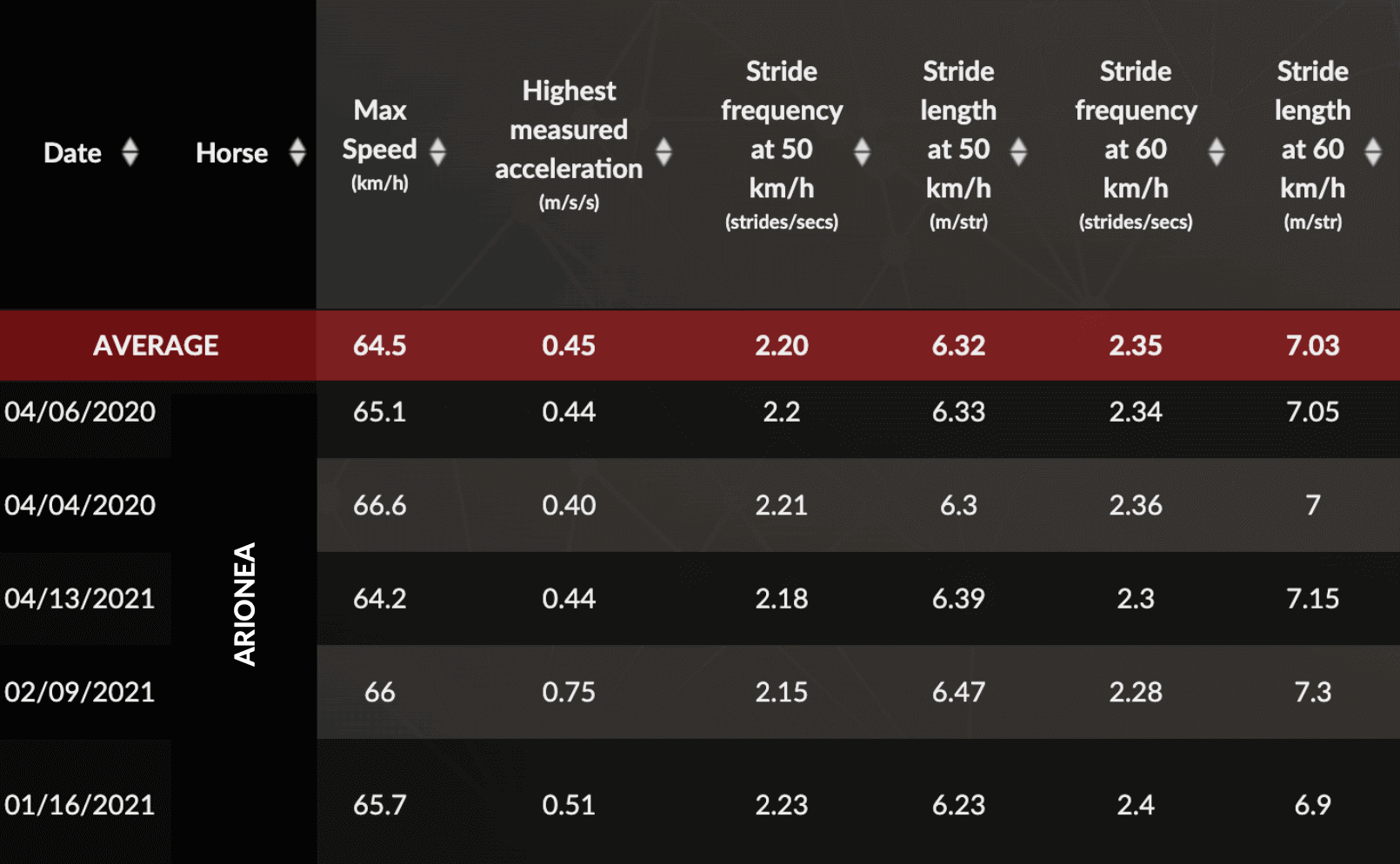
With an average amplitude of 7m/stride and an average cadence of 2.36m/strides at 60km/h, it seems that Arionea uses more her amplitude than her cadence in her strategy. Theoretically, this mare would be more comfortable over a longer distance.
Individualize training
Knowing your horses’ preferences, their physical abilities and their usual performances are essential points to individualize their training and maximize their performance. Indeed, thanks to the knowledge of your horses, you can easily adapt the training, intervene in a more agile way in your working methods and answer the needs of each one. With this advantage, you have the ability to intervene before a counter-performance occurs in the race.
Concrete example: Arion’s case, an under-trained horse
Arion arrived in October 2020 at our client’s stable. The latter has monitored him from the beginning of his training, thus collecting precious information. Victorious in Gr1, the data preceding his victory are references to be obtained before each future major event. At the beginning of 2021, this horse realized a surprising counter-performance. The trainer thought that the horse was doing well, no deterioration of his fitness had been observed. However, once the data was analyzed, the trainer was able to detect a very slight change in the horse’s recovery.
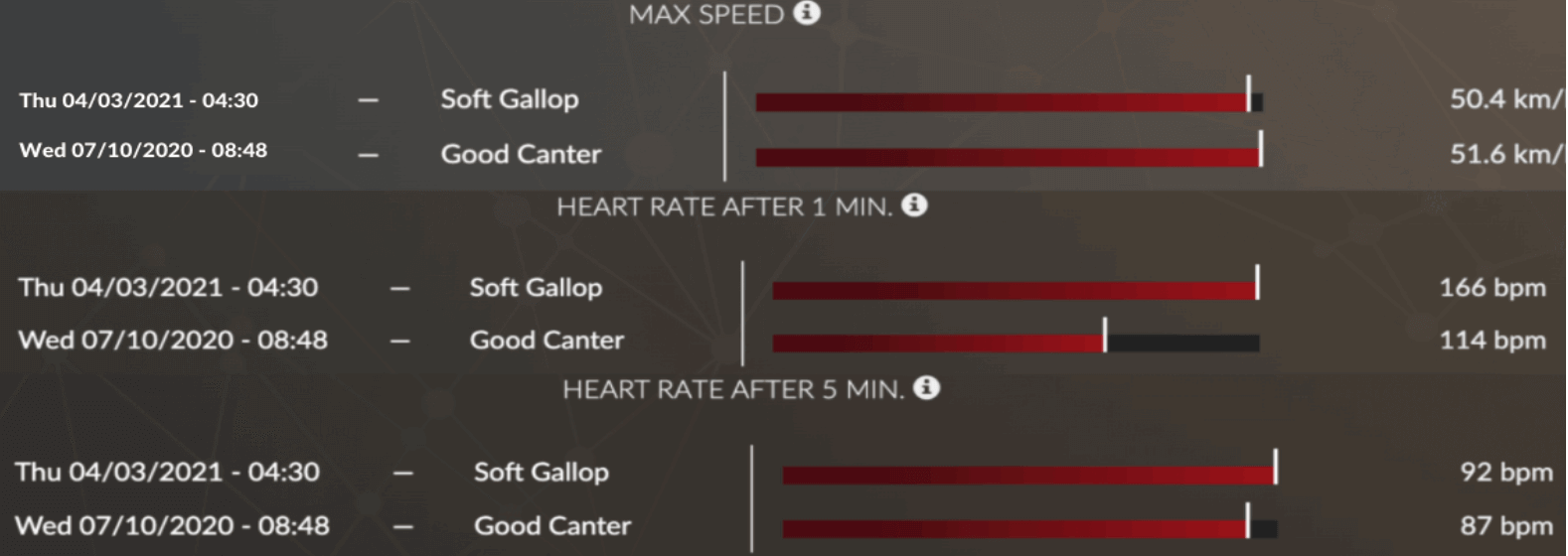
Arion’s recovery from his canter in March 2021 has deteriorated in comparison to his October 2020 canter when he arrived. Although this deterioration is slight (as the horse continues to show excellent recovery), it may be the reason for the underperformance in 2021. The horse had less endurance.
The trainer adapted his training by increasing the workload: the duration and distance covered increased. This allowed the horse to return to good physical condition and to win another Gr1 race.
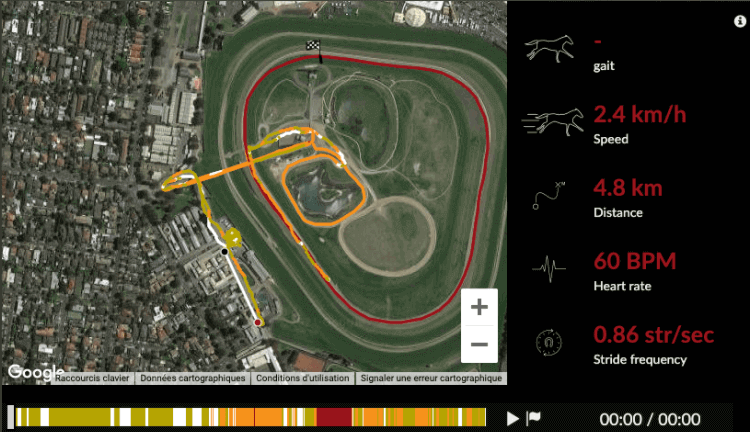

On these screenshots of the EQUIMETRE platform, we can notice that the training distance of this horse has doubled from 4.8 km to 10.4 km.
Thus, in addition to quantifying training, workload and progress, training monitoring allows for establishing strategies based on the specific abilities and potential of each horse. It is therefore relevant to carry out training monitoring in order to prepare for races in an optimal way and to ensure performance on the D day.
3 – Carry out a reinforced medical-sports follow-up
Detecting the warning signs of pathologies
For a horse to perform well, it is essential to monitor its health in order to prevent the risk of injury and to detect the appearance of symptoms. This monitoring can be done through the observations of the trainer, the training rider or the care team, but it is important to complement it with tangible and objective data.
Indeed, although expressive in their behavior, race results and physical appearance, equine athletes are unable to communicate. Their entourage must then redouble their ingenuity to ensure their good physical condition. Some respiratory and cardiac pathologies can only be detected by heart rate and ECG measured during exercise. Analyzing heart rate, evaluating recovery capacity or even the symmetry of gaits are preventive actions that can detect the early signs of serious pathologies.
Concrete example: detect a heart failure
During a training session, Arion reached a heart rate of 250 BPM at the beginning of the gallop. Remember that the maximum heart rate of horses is between 204 and 241 BPM (Evans, 2001). Thus, this abnormal heart rate could be a sign of pain, a heart problem or a respiratory problem.
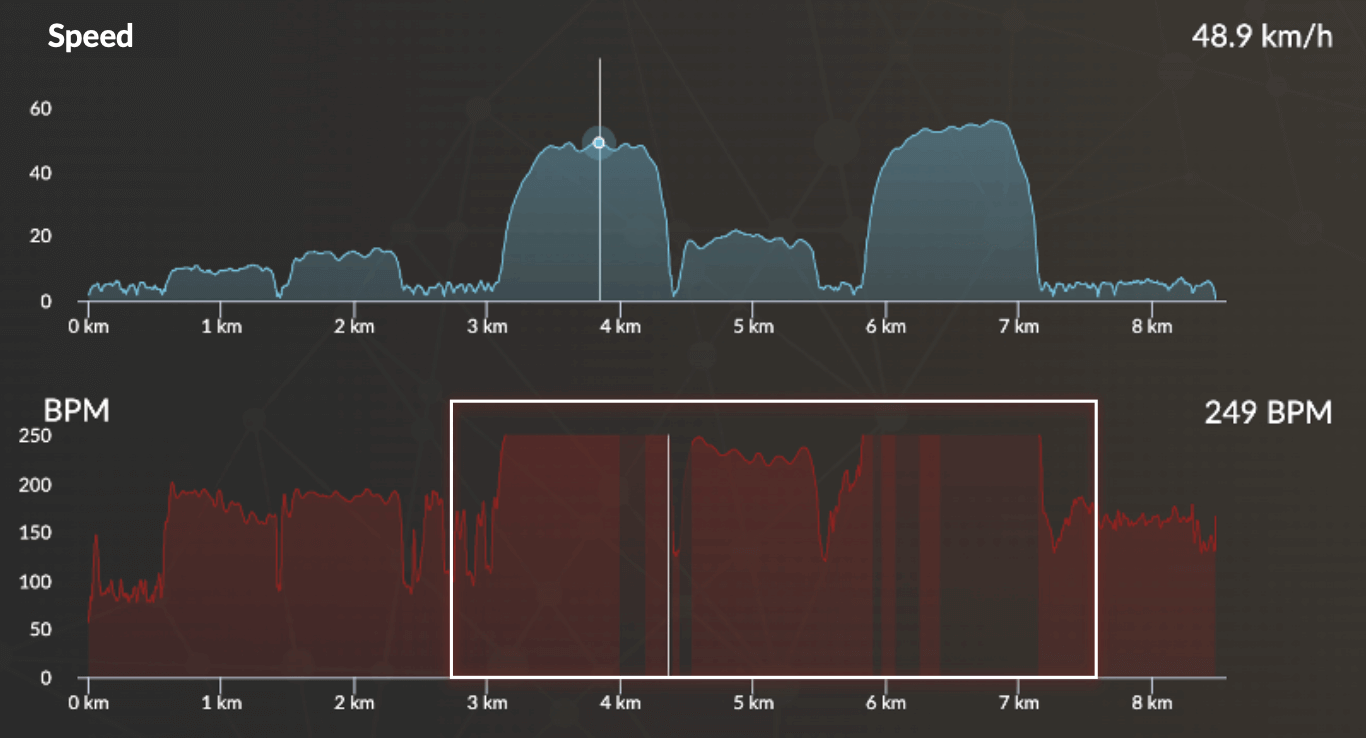
Arion’s veterinarian analyzed the ECG automatically collected by EQUIMETRE during training. The ECG analysis showed that Arion was suffering from a cardiac arrhythmia. Want to know more about the diagnosis? Please click here.
Improve communication with the veterinary team
Several actors take part in a racehorse’s life: like high level athletes, racehorses are followed on a daily basis by different medical teams (veterinarians, osteopaths, nutritional experts etc). The trainer is in direct contact with all these teams and his communication work can sometimes be tedious. The data collected over time can considerably facilitate his communication work because by giving access to the data, the veterinarians can, for example, judge from a distance if an intervention on site for examinations is necessary. The follow-up is more objective, and the number of unnecessary trips is reduced.
Moreover, we have developed a specific feature for veterinarians wishing to practice telemedicine on our EQUIMETRE solution. Thanks to a system of linked mirror accounts, a veterinarian can consult the horses of all his clients and thus analyze the longitudinal work from his office, respond remotely to the trainer’s doubts or detect early signs of pain or abnormal cardio in order to intervene as soon as possible.
Thus, to carry out a follow-up of the training is:
- Ensuring an objective follow-up: quantification of the workload, evaluation of the horse’s evolution, follow-up data
- Adapting training: identifying the preferences of each horse, indivisualizing training
- Facilitating the medical follow-up: detecting the early signs of pathologies, improving communication with the veterinary team
II – How to set up training monitoring?
The implementation of training monitoring requires the collection of a qualified data history thanks to a solution adapted to the monitoring of the training of racehorses which allows the precise and relevant analysis of the physical conditions of your horses.
1 – Find a solution to your needs
Define your needs: what solutions are you looking for?
What data do you want to collect and how do you want to use them?
To collect data on racehorses, it is essential to find a solution adapted to racehorses. Indeed, the collection must be done in the respect of the integrity and the well-being of the horse: it is thus a question of finding a comfortable, painless solution, and which will not cause any disturbance for the horse or the jockey.
Establishing the level of detail you want from your horse monitoring is important when defining your needs. Are you satisfied with basic volume and intensity measurements, or do you need more detail? Do you want to work with internal load measurements (e.g. heart rate) in addition to external load (speed, distance etc.)? Different tracking technologies can have very different functions, so it’s important to define your expectations ahead of time.
What does scientific research say?
A suitable solution must also provide true data that can be analyzed. Indeed, the accuracy of the data is essential to derive a meaningful analysis.
There are a large majority of horse monitoring systems available on the market, however, it is important to verify the reliability of these tools. Those that have undergone rigorous validation testing in university research projects can provide accurate and objective monitoring. If you have access to university research documents, they can be a valuable resource for determining the accuracy and validity of technologies from an independent source.
At Arioneo, reliability and validation of our products is our primary focus. Our goal is to offer the most accurate solution possible to our customers. After more than a year of work, we are proud to bring scientifically validated, medically accurate technology to our veterinary customers.
What is your budget?
Understanding your budget and how you can implement an effective horse training tracking program within that budget is critical to your research success. Tracking technologies are available at a wide range of prices.Identifying the solutions that balance your data requirements and financial resources is essential in your requirement definition process.
By establishing the answers to these questions, it will be easier to narrow your search and filter out solutions that are not right for your stable. Once you have done this, the decision-making process should be easier and you can begin to get into the technical and business details of the remaining systems on your list.
Find a solution that is easy to use and fits into your training routine
Trainers have several horses to train in record time. Offering a solution that is easy to use and practical on the track is also a necessity in order not to waste time and to be able to use it frequently enough to obtain a history of relevant data. Using the solution should not be a problem, and setting it up should be easy and convenient, so that anyone in the stable is able to set it up in seconds.
Making your job easier is also one of our objectives. Indeed, EQUIMETRE is easy and quick to install thanks to an optimized fastening system and a chip reader that allows it to detect the horse without registering it. The installation is done in 30 seconds, and any member of your staff can do it. The start of the monitoring is done in 4 steps:
1- Moisten the electrodes
2 – Turn on the sensor by pressing the button
3 – Scan the veterinary chip
4 – Attach the sensor to the strap
You can also find here installation tutorials that are easily explained, and our teams are here to accompany and advise you throughout your experience with EQUIMETRE.
The platform and the app are very easy to use. Within minutes, you can see the data of the horse coming back from work. It is the latest technology available on the market. And also, the product in itself is very easy to use. It can be switched from horse to horse within minutes. It is very straightforward. I would say that the main advantage is that it is very easy to use.
James Peter
Racehorse trainer in Singapore and Equimetre user since 2020
2 – Collect a qualified data history
The first step to set up a qualitative monitoring of your horses is to collect qualified and analyzable data, that is to say, to collect data that make sense and that give information on the horse’s physical condition and its handling of the effort. Globally, the performance and health evaluation is based on 3 main families of data: cardiac data, speed data and locomotion data.
Training contributes to the improvement of racehorses’ cardiac capacity. Thus, monitoring the physiological parameters contributes to the evaluation of your horses’ cardiac capacity evolution. This monitoring is necessary to objectively measure a racehorse’s fitness, to quantify his progression and to evaluate his ability to run a race.
Knowing the horse’s cadence and amplitude at its maximum speed and comparing these values with the averages during the finish line of a particular race help in developing relevant racing strategies. Indeed, horses with a better cadence can afford to wait until the last moment to launch the sprint because they will quickly reach their maximum speed while horses with a large amplitude will have to launch themselves from further away to reach their maximum speed.
Finally, monitoring speed parameters allows for quantifying speed improvement and thus to meet the objective of increasing speed without deteriorating recovery. These data are also relevant when compared to the reference times of races to confirm a choice of commitment and to get an idea of the horse’s level in relation to the level required for a targeted race.
3 – Analyze the data
Once the solution has been chosen, the last step in monitoring training is to analyze the results and the data collected. Indeed, it is essential to understand and interpret the results in order to exploit them to the fullest and carry out a complete follow-up.
We have worked to offer an intuitive platform, with data that are easy to analyze: in fact, with EQUIMETRE, you benefit from a comparison tool directly integrated into the platform, you also benefit from curves and diagrams to make the analyses more visual and you benefit from the possibility of customizing your tables in order to analyze the data that you find most interesting.
New learning opportunities
Science is not a static discipline and every day many studies are published, defining the field of possibilities, especially in terms of Sports Science! It is essential to be able to follow all these evolutions.
At Arioneo, we are committed to helping our users as well as professionals in the field to increase their knowledge of sports science and training methods. Therefore, we strive to create up-to-date content on the various scientific and technological trends that are evolving around the equine industry.
We accompany you in learning how to analyze data and we help you to become more competent in interpreting the results. Indeed, you can find multiple information and illustration contents adapted to your needs: find data analysis in our blog articles, in our case studies, in our webinars, or in our reports.
Finally, our offers also include data coaching sessions with our teams: indeed, you benefit from a personalized support in order to learn how to use the solution and analyze the data.
III – What are the limits of training monitoring?
1 – Be careful not to drown in too much information
First of all, training monitoring is a relevant and useful strategy if it is carried out with application and methods. Indeed, the data can only be used if it is possible to compare them over time. To do this, it is necessary to collect a certain number of data and to qualify them in order to compare what is comparable: the day, the type of training, the intensity, the track, the weather conditions (etc). Thus, the follow-up of training requires regular monitoring and a certain rigor.
Concrete example
Here is an example of a database of a Group 1 racehorse from one of our users. For confidentiality reasons, we have anonymized this horse.


In addition to the large volume of data, this horse’s trainer also took the time to qualify the workouts. This work facilitates the analysis because it offers the possibility to make relevant comparisons quickly with the Equimetre Analytics Premium tool. This history forms the basis for the longitudinal analysis of ARION’s data. The trainer can thus refer to data according to the different evolutions of the horse: when he performs well, or on the contrary, when he experiences a significant loss of fitness that can lead to a counter-performance.
2 – Data does not replace the trainer’s feeling
Moreover, even if the training follow-up is perfectly done, it is important to remember that the performance depends on a multitude of factors. Indeed, the data gives an indication of the horse’s state of form and his abilities, but on the day of the race, his results will also depend on the quality of the ground, the weather, etc… It is good to remember that at the racetrack, the favorite horse only wins 30% of the time. This statistic is the symbol of the high uncertainty that reigns around the world of horse racing.
Besides, the data collected are good indicators but they cannot be enough on their own. Indeed, horses are sensitive animals, their performances and reactions cannot be reduced to numbers. If data is becoming more and more important, it does not replace the trainer’s feeling. Data should be considered as a support or as an aid, not as an absolute science. Data does not make good horses.
3 – Big data is just entering the equine field
Finally, we are at the dawn of the use of data in the training of racehorses. If other sports are ahead of us, equine sports science is still new. It is a matter of surrounding ourselves with the right people, and learning more about the subject every day by pushing the analysis. At Arioneo, we bring together a team of passionate experts (engineers, data scientists, developers, veterinary experts in sports medicine, and researchers) and we continually seek to innovate and evolve to offer you a successful solution.
Conclusion
In a nutshell, there is a real need to collect data in order to quantify training. The advantages brought by this new practice are decisive in the development of racehorses today. Obviously, the movement is well theorized, and its implementation has already borne fruit. Considering the role of data in other professional sports, its advent in the equestrian world is not in doubt. As a pioneer in this field, Arioneo facilitates the collection of heart rate, speed and locomotion data from racehorses. Our connected horse sensor is a tool already used by top trainers in their quest for victory on the racetrack and for the well-being of their horses. The technological evolution of the equine industry is already underway!
If you want to be accompanied in the implementation of a connected solutions to collect cardio, speed and locomotion data, do not hesitate to get in touch with one of our experts!
